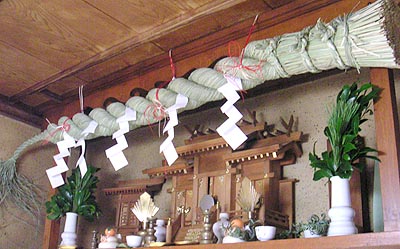|
Bunrei
is a Shinto technical term that indicates both the process of dividing a Shinto ''kami are the deities, divinities, spirits, phenomena or "holy powers", that are venerated in the Shinto religion. They can be elements of the landscape, forces of nature, or beings and the qualities that these beings express; they can also be the ...'' to be re-enshrined somewhere else (such as a house's '' kamidana''), and the spirit itself produced by the division. For details, see the article about the similar term Kanjō. References Traditional rituals of East Asia Shinto Shinto terminology {{Shinto-stub ... [...More Info...] [...Related Items...] OR: [Wikipedia] [Google] [Baidu] |
Kanjō
in Shinto terminology indicates a propagation process through which a ''kami'', previously divided through a process called ''bunrei'', is invited to another location and there re-enshrined. Evolution of the ''kanjō'' process ''Kanjō'' was originally a Buddhist term and later entered Shinto vocabulary.Smyers (1999:235) A ''kanjō'' was the request of the Buddha's sermon with a sincere heart, and later came to mean the urging of a buddha or bodhisattva to remain in this world to preach and save other human beings. The concept then evolved further to mean the act (and the actual words) of asking buddhas or bodhisattvas to descend to the altar during a Buddhist service. In Japan, the word gradually assumed the present meaning of enshrinement of a buddha or ''kami'' in a building for the first time. The ''kanjō'' process Before it can be transferred to its new location the ''kami'' must be divided. The division sub-process and the divided spirit itself are called , or . T ... [...More Info...] [...Related Items...] OR: [Wikipedia] [Google] [Baidu] |
Shinto
Shinto () is a religion from Japan. Classified as an East Asian religion by scholars of religion, its practitioners often regard it as Japan's indigenous religion and as a nature religion. Scholars sometimes call its practitioners ''Shintoists'', although adherents rarely use that term themselves. There is no central authority in control of Shinto, with much diversity of belief and practice evident among practitioners. A polytheistic and animistic religion, Shinto revolves around supernatural entities called the . The are believed to inhabit all things, including forces of nature and prominent landscape locations. The are worshiped at household shrines, family shrines, and ''jinja'' public shrines. The latter are staffed by priests, known as , who oversee offerings of food and drink to the specific enshrined at that location. This is done to cultivate harmony between humans and and to solicit the latter's blessing. Other common rituals include the dances, rites of pa ... [...More Info...] [...Related Items...] OR: [Wikipedia] [Google] [Baidu] |
Kamidana
are miniature household altars provided to enshrine a Shinto . They are most commonly found in Japan, the home of worship. The is typically placed high on a wall and contains a wide variety of items related to Shinto-style ceremonies, the most prominent of which is the , an object meant to house a chosen , thus giving it a physical form to allow worship. are most commonly small circular mirrors, though they can also be jewels, or some other object with largely symbolic value. The within the is often the deity of the local shrine or one particular to the house owner's profession. A part of the () was obtained specifically for that purpose from a shrine through a process called . Worship at the typically consists of the offering of simple prayers, food (e.g., rice, fruit, water) and flowers. Before worshiping at the it is ritually important for family members to cleanse their hands or mouth. can also be found in some traditional Japanese martial arts dojos. Acquisit ... [...More Info...] [...Related Items...] OR: [Wikipedia] [Google] [Baidu] |
Kami
are the deities, divinities, spirits, phenomena or "holy powers", that are venerated in the Shinto religion. They can be elements of the landscape, forces of nature, or beings and the qualities that these beings express; they can also be the spirits of venerated dead people. Many ''kami'' are considered the ancient ancestors of entire clans (some ancestors became ''kami'' upon their death if they were able to embody the values and virtues of ''kami'' in life). Traditionally, great leaders like the Emperor could be or became ''kami''. In Shinto, ''kami'' are not separate from nature, but are of nature, possessing positive and negative, and good and evil characteristics. They are manifestations of , the interconnecting energy of the universe, and are considered exemplary of what humanity should strive towards. ''Kami'' are believed to be "hidden" from this world, and inhabit a complementary existence that mirrors our own: . To be in harmony with the awe-inspiring aspects of na ... [...More Info...] [...Related Items...] OR: [Wikipedia] [Google] [Baidu] |
Traditional Rituals Of East Asia
A tradition is a belief or behavior (folk custom) passed down within a group or society with symbolic meaning or special significance with origins in the past. A component of cultural expressions and folklore, common examples include holidays or impractical but socially meaningful clothes (like lawyers' wigs or military officers' spurs), but the idea has also been applied to social norms such as greetings. Traditions can persist and evolve for thousands of years—the word ''tradition'' itself derives from the Latin ''tradere'' literally meaning to transmit, to hand over, to give for safekeeping. While it is commonly assumed that traditions have an ancient history, many traditions have been invented on purpose, whether that be political or cultural, over short periods of time. Various academic disciplines also use the word in a variety of ways. The phrase "according to tradition", or "by tradition", usually means that whatever information follows is known only by oral tradition, ... [...More Info...] [...Related Items...] OR: [Wikipedia] [Google] [Baidu] |



